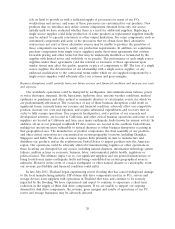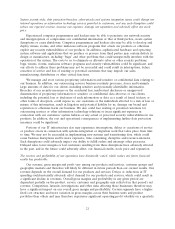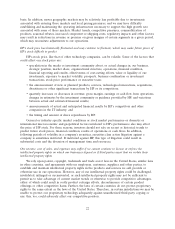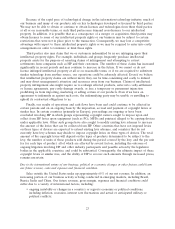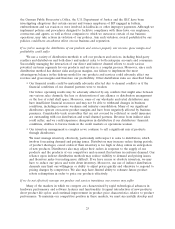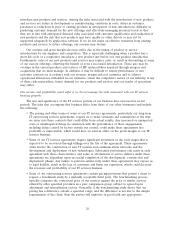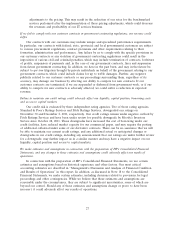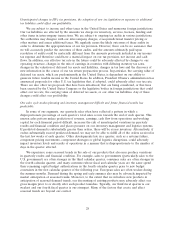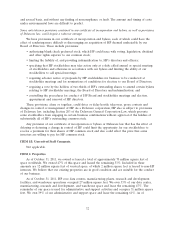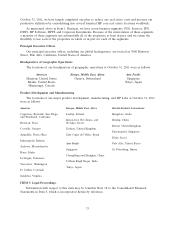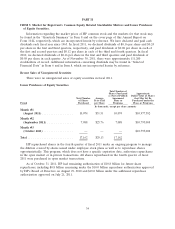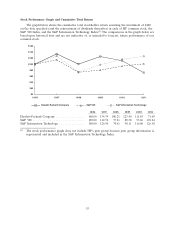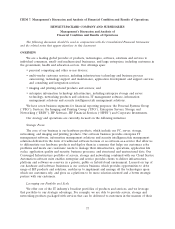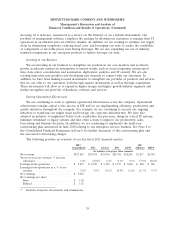HP 2011 Annual Report Download - page 38
Download and view the complete annual report
Please find page 38 of the 2011 HP annual report below. You can navigate through the pages in the report by either clicking on the pages listed below, or by using the keyword search tool below to find specific information within the annual report.or conduct certain other critical business operations. The potential for future attacks, the national and
international responses to attacks or perceived threats to national security, and other actual or potential
conflicts or wars, including the military operations now being wound down in Iraq and the ongoing
military operations in Afghanistan have created many economic and political uncertainties. In addition,
as a major multinational company with headquarters and significant operations located in the United
States, actions against or by the United States may impact our business or employees. Although it is
impossible to predict the occurrences or consequences of any such events, they could result in a
decrease in demand for our products, make it difficult or impossible to provide services or deliver
products to our customers or to receive components from our suppliers, create delays and inefficiencies
in our supply chain and result in the need to impose employee travel restrictions. We are
predominantly uninsured for losses and interruptions caused by terrorist acts, conflicts and wars.
Any failure by us to identify, manage, complete and integrate acquisitions, divestitures and other significant
transactions successfully could harm our financial results, business and prospects, and the costs, expenses
and other financial and operational effects associated with managing, completing and integrating
acquisitions may result in financial results that are different than expected.
As part of our business strategy, we frequently acquire complementary companies or businesses,
divest non-core businesses or assets, enter into strategic alliances and joint ventures and make
investments to further our business (collectively, ‘‘business combination and investment transactions’’).
In order to pursue this strategy successfully, we must identify suitable candidates for and successfully
complete business combination and investment transactions, some of which may be large or complex,
and manage post-closing issues such as the integration of acquired businesses, products or employees.
We may not fully realize all of the anticipated benefits of any business combination and investment
transaction, and the timeframe for achieving benefits of a business combination and investment
transaction may depend partially upon the actions of employees, suppliers or other third parties. In
addition, the pricing and other terms of our contracts for business combination and investment
transactions require us to make estimates and assumptions at the time we enter into these contracts,
and, during the course of our due diligence, we may not identify all of the factors necessary to estimate
our costs accurately. Any increased or unexpected costs, unanticipated delays or failure to meet
contractual obligations could make these transactions less profitable or unprofitable. Moreover, if we
fail to identify and successfully complete business combination and investment transactions that further
our strategic objectives, we may be required to expend resources to develop products and technology
internally, we may be at a competitive disadvantage or we may be adversely affected by negative market
perceptions, any of which could adversely affect our revenue, gross margin and profitability.
Integration issues are often complex, time-consuming and expensive and, without proper planning
and implementation, could significantly disrupt our business. The challenges involved in integration
include:
• combining product offerings and entering into new markets in which we are not experienced;
• convincing customers and distributors that the transaction will not diminish client service
standards or business focus, preventing customers and distributors from deferring purchasing
decisions or switching to other suppliers (which could result in our incurring additional
obligations in order to address customer uncertainty), minimizing sales force attrition and
coordinating sales, marketing and distribution efforts;
• consolidating and rationalizing corporate IT infrastructure, which may include multiple legacy
systems from various acquisitions and integrating software code;
• minimizing the diversion of management attention from ongoing business concerns;
30


